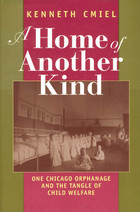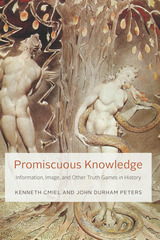3 books by Cmiel, Kenneth

A Home of Another Kind
One Chicago Orphanage and the Tangle of Child Welfare
Kenneth Cmiel
University of Chicago Press, 1995
In the most comprehensive account ever written of an American orphanage, an institution about which even its many new advocates and experts know little, Kenneth Cmiel exposes America's changing attitudes toward child welfare.
The book begins with the fascinating history of the Chicago Nursery and Half-Orphan Asylum from 1860 through 1984, when it became a full-time research institute. Founded by a group of wealthy volunteers, the asylum was a Protestant institution for Protestant children—one of dozens around the country designed as places where single parents could leave their children if they were temporarily unable to care for them.
But the asylum, which later became known as Chapin Hall, changed dramatically over the years as it tried to respond to changing policies, priorities, regulations, and theories concerning child welfare. Cmiel offers a vivid portrait of how these changes affected the day-to-day realities of group living. How did the kind of care given to the children change? What did the staff and management hope to accomplish? How did they define "family"? Who were the children who lived in the asylum? What brought them there? What were their needs? How did outside forces change what went on inside Chapin Hall?
This is much more than a richly detailed account of one institution. Cmiel shatters a number of popular myths about orphanages. Few realize that almost all children living in nineteenth-century orphanages had at least one living parent. And the austere living conditions so characteristic of the orphanage were prompted as much by health concerns as by strict Victorian morals.
The book begins with the fascinating history of the Chicago Nursery and Half-Orphan Asylum from 1860 through 1984, when it became a full-time research institute. Founded by a group of wealthy volunteers, the asylum was a Protestant institution for Protestant children—one of dozens around the country designed as places where single parents could leave their children if they were temporarily unable to care for them.
But the asylum, which later became known as Chapin Hall, changed dramatically over the years as it tried to respond to changing policies, priorities, regulations, and theories concerning child welfare. Cmiel offers a vivid portrait of how these changes affected the day-to-day realities of group living. How did the kind of care given to the children change? What did the staff and management hope to accomplish? How did they define "family"? Who were the children who lived in the asylum? What brought them there? What were their needs? How did outside forces change what went on inside Chapin Hall?
This is much more than a richly detailed account of one institution. Cmiel shatters a number of popular myths about orphanages. Few realize that almost all children living in nineteenth-century orphanages had at least one living parent. And the austere living conditions so characteristic of the orphanage were prompted as much by health concerns as by strict Victorian morals.
[more]

The Ladies' Etiquette Handbook
The Importance of Being Refined in the 1880s
David E. Schoonover
University of Iowa Press
Prior to the late nineteenth century, most Americans viewed dining as a utilitarian duty characterized by common “meat and potato” dishes and complemented by little, if any, polite conversation. With the boom in industrialism and the sudden growth of the middle class in the 1880s, America's interest in social etiquette rose dramatically.
Consisting of two separate publications—The Ladies' Handbook and Household Assistant(1886) and Short Hints on Social Etiquette (1887)—The Ladies' Etiquette Handbook can be read as a testament to the growing division between social classes and, at the same time, as a reflection of the middle class' overwhelming desire to cross social lines through the graces of fine etiquette.
Written by a Methodist women's church group in Manchester, New Hampshire, The Ladies' Handbook and Household Assistant provides advice on subjects such as church etiquette and the proper handling of cutlery as well as recipes for the socially active household. Short Hints on Social Etiquette, published as a promotional piece by a Philadelphia soap manufacturer—including descriptions of lavish meals, advice on proper word pronunciation, and illustrations of tasteful calling cards—strives to bring “aristocratic” values into the “republican” home.
The foreword by Kenneth Cmiel, professor of history at the University of Iowa, provides an overview of the historic and social trends leading up to the publication of both handbooks and traces the creation and ultimate development of modern social etiquette.
[more]

Promiscuous Knowledge
Information, Image, and Other Truth Games in History
Kenneth Cmiel and John Durham Peters
University of Chicago Press, 2020
Sergey Brin, a cofounder of Google, once compared the perfect search engine to “the mind of God.” As the modern face of promiscuous knowledge, however, Google’s divine omniscience traffics in news, maps, weather, and porn indifferently. This book, begun by the late Kenneth Cmiel and completed by his close friend John Durham Peters, provides a genealogy of the information age from its early origins up to the reign of Google. It examines how we think about fact, image, and knowledge, centering on the different ways that claims of truth are complicated when they pass to a larger public. To explore these ideas, Cmiel and Peters focus on three main periods—the late nineteenth century, 1925 to 1945, and 1975 to 2000, with constant reference to the present. Cmiel’s original text examines the growing gulf between politics and aesthetics in postmodern architecture, the distancing of images from everyday life in magical realist cinema, the waning support for national betterment through taxation, and the inability of a single presentational strategy to contain the social whole. Peters brings Cmiel’s study into the present moment, providing the backstory to current controversies about the slipperiness of facts in a digital age. A hybrid work from two innovative thinkers, Promiscuous Knowledge enlightens our understanding of the internet and the profuse visual culture of our time.
[more]
READERS
Browse our collection.
PUBLISHERS
See BiblioVault's publisher services.
STUDENT SERVICES
Files for college accessibility offices.
UChicago Accessibility Resources
home | accessibility | search | about | contact us
BiblioVault ® 2001 - 2024
The University of Chicago Press









